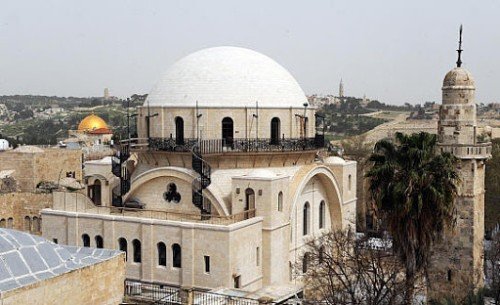A nice Tour to Hurva Synagogue
Hurva synagogue.
This church was founded in the eighteenth century by the Followers of Judah and it was built on the rescue of another synagogue that was in the fifteenth century. Unfortunately, it was destroyed after several years of its construction by the Ottoman authorities because its owners could not pay the debts.
In 1864 a Jewish sect rebuilt the church. Although his name was Peace Yacoub, it kept his name, which was Hurva which is the main Ashkenazi Synagogue.
Unfortunately, it was destroyed by the Arab armies during the Arab-Israeli war in 1948, after Israel captured East Jerusalem in 1967, a new building was designed and a memorial was made in the place of this synagogue in 1977 in the form of an arch
This synagogue became the site which is in the shape of an arch and it was one of the prominent in the Jewish quarter, and in 2000 the Jewish synagogue was built in the style of the nineteenth century, after the approval of the Israeli government.
The location of Hurva Synagogue.
This Jewish synagogue is now in front of a yard in the Jewish quarter of Jerusalem, and by the advent of the thirteenth century, this area became as Dair Ashkenazi and it was dedicated to Ashkenazi.
In 1488, a Jewish person rose in a large yard containing many houses devoted to the Ashkenazi. The worship is shared between Ashkenazim and Sephardim, and in 1586 the Ottoman authorities confiscated the building, so the Ashkenazim established a synagogue in a nearby yard.
In 1717 a large number of Ashkenazi Jews led a person called Judah came to Jerusalem and settled in Jerusalem and lived an ascetic life and after a few days of their arrival in Jerusalem their leader died and after that they tried to build the largest synagogue and this would cost them a lot of money.
Therefore this group borrowed a lot of money from the Arabs in Jerusalem. An envoy from them also travelled to European countries to bring money to build this synagogue, and after building the synagogue they could not pay a lot of money so it was burned by the Arabs.
Therefore, a large number of Ashkenazim were imprisoned, as well as the Ashkenazim were expelled outside the city, and after that a lot of shops were built in this yard the Jewish synagogue. The synagogue was left deserted in the rubble.
Perushim efforts.
In 1700, a group of Jews bought this destroyed courtyard, and unfortunately it was destroyed again in 1721, and after 1808 to 1812, a group of ascetic Jews bought this place and their name was Perushim who immigrated from Lithuania to Palestine and settled in a city that called Safd.
Some of them wanted to settle in Jerusalem and wanted to regain the Ashkenazi compound, but they were worried about descendants of Arab creditors because they were demanding money.
In 1815 Rabbi Menachem Mendel arrived from Shaqouf to Jerusalem, and he had a group of his followers with him and made a lot of effort to build the synagogue of Hohseed which was symbolic of the Ashkenazi.
They wanted to reconfigure the Ashkenazim in Jerusalem. In 1816 the Jews appealed to the Ottoman authorities in Constantinople to obtain a royal decree so that the Arabs would not have the right to request money from the Ashkenazim.
But this did not happen after that in 1819, the efforts of the Jews succeeded as a legal document was issued cancelling the debts of the Jews as well as exempting them from all debts as well as a decree was issued allowing the Jews to build on the site of the synagogue.
Egypt grants a strange approval to the Jews.
In 1831 Egypt annexed Jerusalem, and therefore an opportunity appeared in front of the Jews to be an Ashkenazi community in Jerusalem, and that they made a lot of effort because they demand decree from Muhammad Ali Pasha, the ruler of Egypt to rebuild the Jewish synagogue.
But there were fears of deviation from the Islamic tradition and after five Months after the earthquake of 1843 Sephardim was allowed to carry out repair work in their synagogues and that encouraged the Jews to make a great effort to rebuild this synagogue.
In 1836 the Jews got this decree from Mohamed Ali those who were requesting from the Ottoman authorities succeeded with the support of the Austrian consul and the Russian consul because Muhammad Ali Pasha wanted to get the support of Austria and Russia, so he greened this decree, which stipulates that Jews should be allowed to build this synagogue.
The independence of Menachem Zion Synagogue.
In 1836, the Jews began to remove the rubble from A yard of rubble and The Jews also found the ruins of the original Hohsed synagogue. They also discovered some old documents dating back to 1579.
After a great controversy, the Jews decided to build this synagogue at the beginning of the matter they designed a small structure on the edge of the Ashkenazi complex, and the Arab creditors refused to concede Regarding their allegations about the Jews, as well as they continued to interfere in the construction work.
The Jews justified their construction that the Ashkenazim in Jerusalem had no relationship with the Ashkenazi who borrowed money from the Arabs after that a decision was issued by the Ottoman authorities to allow the Jews to build in this place, and the Arab creditors were appeased with the money. This synagogue was built.
So you will visit one of the wonderful Jewish buildings that you did not see anywhere else. After that, enjoy your visit to Jerusalem and after completing your visit you will be able to do wonderful tours.
You can visit many places in Jerusalem, besides the Jewish archaeological sites. You can visit the Christian archaeological sites located on Mount Al-Tur and inside the old city of Jerusalem. You can also visit the Al-Aqsa Mosque, which contains more than 200 wonderful archaeological sites such as the Dome of the Rock and others.
 English
English
 Español
Español
 Chinese
Chinese
 français
français
 português
português
 Italian
Italian
 Russian
Russian
 Czech
Czech
 Deutsch
Deutsch
 Japanese
Japanese









